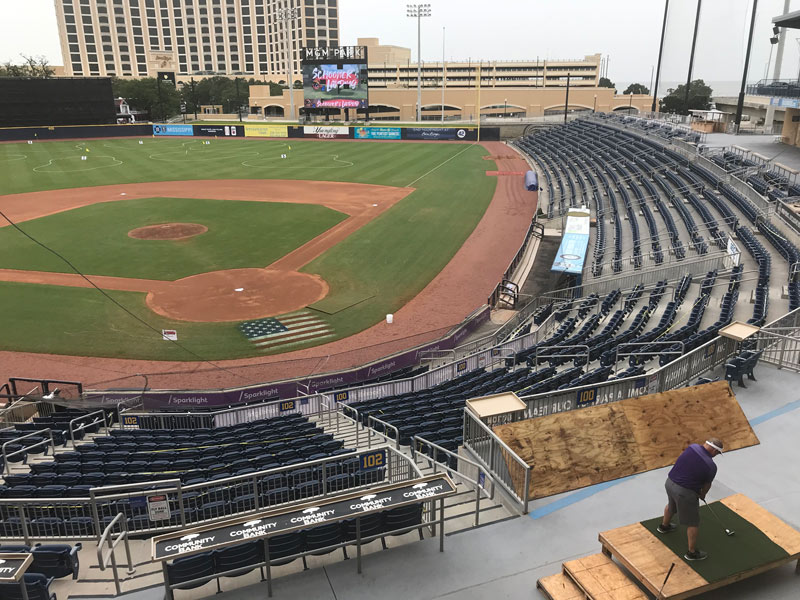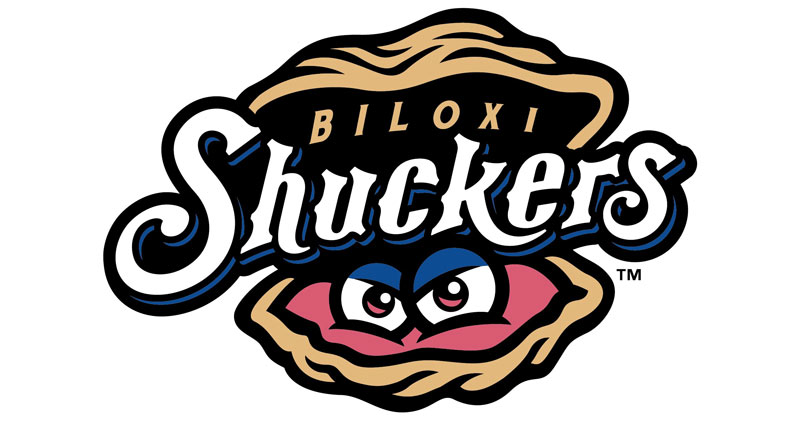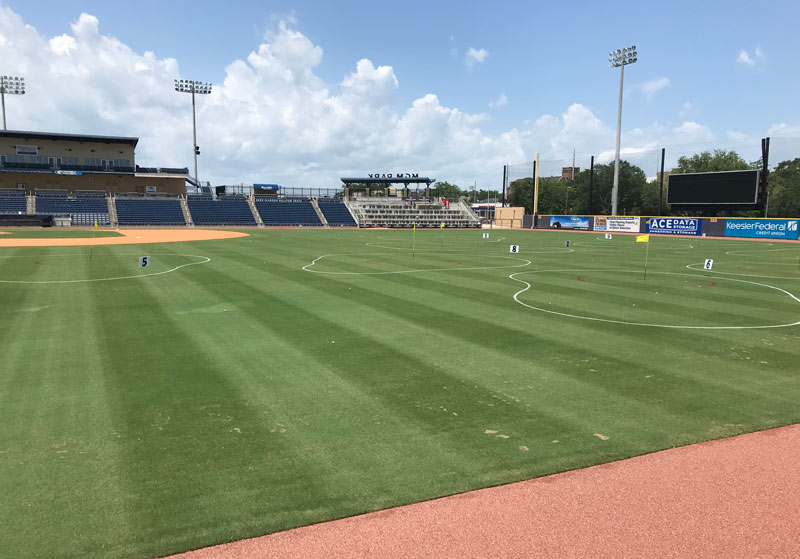
MGM Park, home to the Biloxi (Miss.) Shuckers baseball team, is hosting swings of a different sort this summer with its “Schooner’s Landing” nine-hole golf course and Topgolf-esque target-challenge offering. Photos courtesy of Reuben Wedgeworth
Reuben Wedgeworth had been a golf course superintendent for close to 20 years when he felt it was time for a change.
He moved into sales, then struck out on his own. He contracted with the minor league Biloxi (Miss.) Shuckers — the Double-A affiliate of the Milwaukee Brewers — to install ryegrass at their MGM Park, which opened in 2015. In March 2020, with the team’s season nearing and its head greenkeeper position unfilled, Wedgeworth agreed to take the role.
Now, however, he’s back tending to a golf course. At the baseball stadium.
“I guess,” Wedgeworth says with a laugh, “I’ve come full circle.”
The minor league baseball season has been one of the many casualties of the coronavirus pandemic. Major League Baseball announced on June 30 that MLB-affiliated minor league teams would not play in 2020. Though the Shuckers have been able to host college and, recently, youth baseball games and tournaments, their primary revenue stream has run dry.
The Shuckers staff had previously entertained the idea of temporarily turning MGM Park into a nine-hole golf course, and when the plug was pulled on baseball, they decided to give it a go.
“Our GM, Hunter Reed, brought the idea to me, knowing my background in golf,” Wedgeworth says. “They had talked about it in years past, something for the off-season, but they never brought it to fruition. I was like, ‘Yeah, we can do that.’”

To transform the stadium, Wedgeworth selected nine teeing areas and laid out nine “greens” in the outfield. When the idea first arose about a month ago, he lowered the mowing height on the field’s Tifway 419 bermudagrass to make the greens stand out. But Wedgeworth is operating without a staff, so the additional upkeep didn’t make sense.
Now, he marks the greens with white paint, inside of which is a smaller red ring. At the center of the ring sits the hole — a piece of 1¼-inch PVC pipe sunk into the ground that holds the flagstick.
Golfers, accompanied by a team staffer “caddie,” move throughout the ballpark from tee to tee, taking aim from artificial turf “tees” at the nine flags that range from 68 to 116 yards away. A ball that lands inside the red circle counts as a birdie. Inside the white green is a par. A ball that lands outside the green but on the field is a bogey. A ball that clatters elsewhere in the stadium is a double bogey.
Wedgeworth considered cutting actual cups, but figured repairing the smaller holes in his sand-based field would be easier.
“It would be very easy to fill those up with sand once we pull those pipes out,” he says. “We’ve had some traveling baseball, 14- to 18-year-olds, the weekends before this, and two weeks after the golf. We didn’t want to have big areas, cup-sized, to have to fill back in.”
The Shuckers borrowed flagsticks from nearby Fallen Oak Golf Club, where GCSAA Class A superintendent Matt Hughes, a 22-year association member, is director of grounds. Fallen Oak had been scheduled to host the Rapiscan Systems Classic, a PGA Tour Champions event, March 27-29, but the event was canceled because of the pandemic.
Proudly letting their Rapiscan flags fly, the Shuckers staff scrambled to ready the course — dubbed “Schooner’s Landing” — in time to open for the July Fourth holiday. They even printed scorecards. Wedgeworth says roughly 40 golfers played through that first weekend.
“I think response was good,” he says. “People had a good time. By the time we got it put together, we didn’t get the info out until the first part of the week. There wasn’t a lot of lead-up time. The word is out now, and now that more people are home, hopefully more people will come out.”

Well-kept turfgrass is a terrible thing to waste: MGM Park, located on the Mississippi Coast and shown here in golf course form, features Tifway 419 bermudagrass tended by former golf course superintendent Reuben Wedgeworth.
The Shuckers plan to hold two more weekends of golf, then take a break until fall.
“I think our goal is, we’d like to fill all our tee times up with foursomes,” says Wedgeworth, who had been a GCSAA member for 17 years. “We had 30-minute tee times, but we could shorten that to 15 minutes.”
In addition to the nine-hole stadium course, golfers can also try their hand at a Topgolf-like experience. MGM Park has two “party decks” that can be booked for a target challenge. The nine-hole course is open from 8:30 a.m. to 2 p.m. The target challenge — during which golfers take their swings from the elevated suite-level party decks at any of the nine holes and keep their own scores — is open in the evenings.
“We can have up to eight on the two party decks,” Wedgeworth says. “We’d like to fill up all the foursomes, then fill up the slots on the party decks. We can’t have minor league baseball, so we’re just trying to generate some kind of revenue.”
The Shuckers aren’t the only minor league team repurposing their silent stadium into a golf course. The Portland (Maine) Sea Dogs, Double-A affiliate of the Boston Red Sox, will similarly turn their Hadlock Field into the nine-hole Hadlinks Golf Club. That promotion is scheduled to run July 9-12.
Andrew Hartsock is GCM’s managing editor.